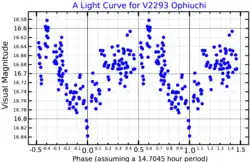GRO J1719-24
GRO J1719-24 (GRS 1716-249, V2293 Oph, X-Ray Nova Ophiuchi 1993) is believed to be a low-mass X-ray binary.[2] Its name derives from an X-ray transient, detected in 1993.[3] The system consists of a black hole candidate and a low mass companion, estimated to be a main sequence star of the spectral type K0-5 V.[4]
 A visual band light curve showing superhumps of V2293 Ophiuchi, adapted from Masetti et al. (1996)[1] | |
| Observation data Epoch J2000 Equinox J2000 | |
|---|---|
| Constellation | Ophiuchus |
| Right ascension | 17h 19m 37s |
| Declination | −25° 01′ 03″ |
| Apparent magnitude (V) | 16.65 |
| Astrometry | |
| Distance | 8500 ly (2600 pc) |
| Absolute magnitude (MV) | ≥6[2] |
| Database references | |
| SIMBAD | data |
The rotation period is uncertain, estimated at 14.7h.[1] The light curve possibly exhibits some faster fluctuations as well, which are hypothesized to be produced by blobs of matter in the accretion disk.[1]
References
- Masetti, N.; Bianchini, A.; Bonibaker, J.; della Valle, M.; Vio, R. (October 1996). "The superhump phenomenon in GRS 1716-249 (=X-Ray Nova Ophiuchi 1993)". Astronomy and Astrophysics. 314: 123–130. Bibcode:1996A&A...314..123M. Retrieved 5 February 2022.
- Della Valle, M.; Mirabel, I.F.; Rodriguez, L.F. (1994), "The optical and radio counterpart of the X-ray Nova Ophiuchi 1993", Astronomy and Astrophysics, 290: 803, Bibcode:1994A&A...290..803D
- Ballet, J.; Denis, M.; Gilfanov, M.; R., Sunyaev (1993), IAU Circ., vol. 5874
- Chaty, S.; Mirabel, I. F.; Goldoni, P.; Mereghetti, S.; Duc, P.-A.; Martí, J.; Mignani, R. P. (2002), "Near-infrared observations of Galactic black hole candidates", MNRAS, 331 (4): 1065–1071, arXiv:astro-ph/0112329, Bibcode:2002MNRAS.331.1065C, doi:10.1046/j.1365-8711.2002.05267.x, S2CID 15529877
This article is issued from Wikipedia. The text is licensed under Creative Commons - Attribution - Sharealike. Additional terms may apply for the media files.